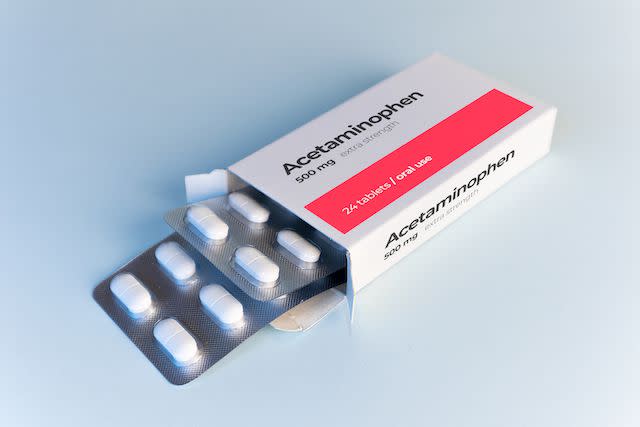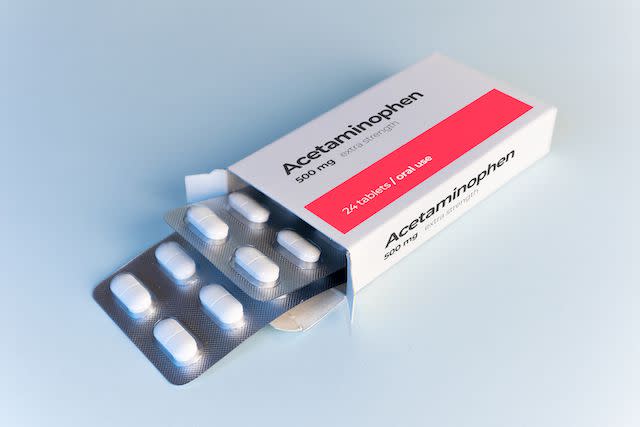Acetaminophen vs. Paracetamol: Is There a Difference?

Medically reviewed by Alex Yampolsky, PharmD
A common pain-relieving drug, acetaminophen, also known as paracetamol, treats mild to moderate muscle aches, headaches, colds, menstrual periods, and reactions to vaccinations (shots) and is used for fever reduction, amongst other conditions.
Paracetamol is another name for acetaminophen. Specifically, the term paracetamol is used in European countries, Australia, India, and New Zealand. While in the USA, Canada, and various other countries, it is called acetaminophen.
Despite the difference in name, there are no significant differences in the chemical structure or indications of acetaminophen and paracetamol. Acetaminophen and paracetamol are categorized as both non-opioid analgesics (pain relievers) and antipyretic agents (fever relievers).
However, there may be some differences between recommended doses and available strengths of the known brands.
This article will highlight the primary characteristics of each drug, considering dosing guidelines, potential side effects, storage information, and more.

Overview: Acetaminophen vs. Paracetamol
Acetaminophen and paracetamol are available by prescription and over-the-counter (OTC) as widely used fever and pain relievers. Both are well-tolerated and safe, without adverse effects typically observed with aspirin.
Acetaminophen and paracetamol are available in various combinations under different brand names.
The following outlines basic information, both shared and specific, to each drug.
How They Work
As mentioned, acetaminophen and paracetamol are classified as non-opioid analgesic and antipyretic agents. Within the scientific community, they are referred to as N-acetyl-p-aminophenol (APAP).
Non-opioid analgesics are a class of drugs used to manage and treat pain. They include nonsteroidal anti-inflammatory drugs (NSAIDs), antidepressants, anti-epileptics, and local anesthetics.
In comparison, antipyretic agents treat the symptoms associated with bodily pain and fever, including corticosteroids (steroids). Acetaminophen is not carcinogenic (carrying the potential to cause cancer).
The mechanism of action of these drugs is still unclear. However, it generally works by changing how the body senses pain and cooling the body.
What They Treat
Acetaminophen and paracetamol relieve mild to moderate pain, including headaches, menstrual periods, muscle soreness, colds, vaccination (shot) pain, and fever reduction.
Acetaminophen and paracetamol are also helpful in relieving the pain of osteoarthritis (arthritis caused by the breakdown of the lining of the joints).
Associated Brand Names
Everyday branded products that contain either acetaminophen or paracetamol include:
FeverAll
Panadol
Tempra Quicklets
Tylenol
Combination products that contain either acetaminophen or paracetamol, alongside other active ingredients, include some of the following:
Dayquil (acetaminophen, dextromethorphan, and pseudoephedrine)
Panadol Extra (acetaminophen and caffeine)
NyQuil Cold/Flu Relief (acetaminophen, dextromethorphan, and doxylamine)
Percocet (acetaminophen and oxycodone)
How Effective Are Acetaminophen and Paracetamol?
Acetaminophen and paracetamol are among the most popular and most commonly used analgesic and antipyretic drugs worldwide.
They are available without a prescription in mono- and multi-component preparations. Acetaminophen/paracetamol is the drug of choice in people that cannot be treated with non-steroidal anti-inflammatory drugs (NSAIDs).
These include salicylate-sensitized people, peptic ulcer disease, people with bronchial asthma, hemophilia, children under 12, and pregnant or breastfeeding people.
According to the Food and Drug Administration (FDA), hundreds of approved prescription and over-the-counter (OTC) products contain acetaminophen as an acetaminophen/paracetamol ingredient.
When used as directed, acetaminophen/paracetamol is very safe and effective. In addition to pain relief and fever reduction, recent laboratory and pre-clinical studies showed many off-label benefits of acetaminophen.
How are Acetaminophen and Paracetamol Taken?
Acetaminophen and paracetamol are available under many brand names, each with its administration and dosing specifications.
Some standard dosing regimens are as follows:
Acetaminophen for minor aches and pains:
Oral liquid: 160 milligrams (mg) per 5 milliliters (mg/mL)
Oral tablet: 325 mg
Oral capsule: 325 mg
Take all the doses every four hours for up to 10 days.
Acetaminophen for fever reduction:
Oral liquid: 160 mg/mL and 640 mg (20 mL)
Oral tablet: 325 mg
Oral capsule: 650 mg (two capsules)
Take oral liquid or tablet every four to six hours for up to three days.
Another commonly used brand is Panadol, which contains paracetamol and a combination of paracetamol and caffeine. This branded product contains 500 mg of paracetamol and 65 mg of caffeine. Take two tablets every four to six hours as needed.
Acetaminophen/paracetamol for kids:
All brands of acetaminophen/paracetamol are safe as antipyretic and analgesic medicine for children ages 2 and older.
Consult your healthcare provider when giving to a child younger than 2. When pregnant or breastfeeding, ask your healthcare provider.
Duration of Effect: Acetaminophen vs. Paracetamol
Oral paracetamol has excellent bioavailability (the ability of a drug to be absorbed in the body to produce a therapeutic effect).
Specifically, oral paracetamol reaches its peak plasma concentrations within 30 to 60 minutes after ingestion, known as a half-life (when half of the drug is expelled from the body) is about 120 minutes. Some 90% to 100% of the drug may be discharged in the urine within 24 hours of administration.
In comparison, acetaminophen has a high oral bioavailability of 88%. It absorbs well and reaches the peak blood concentrations within 90 minutes after ingestion.
Acetaminophen distributes widely throughout most body tissues except in fats. It has a 1.5 to 2.5 hours plasma half-life at the recommended doses.
Side Effects
Acetaminophen and paracetamol are widely used and are safe when taken in recommended doses. However, potential side effects/safety hazards associated with their use are listed below.
Common Side Effects
Common side effects associated with the use of acetaminophen and paracetamol include:
Nausea
Vomiting
Constipation
Abdominal pain
Severe Side Effects
More severe effects associated with the use of acetaminophen and paracetamol include:
Hypersensitivity to one of the active ingredients in acetaminophen/paracetamol. As a result, acetaminophen/paracetamol should not be used by people hypersensitive to any formulation component.
Liver damage (acetaminophen/paracetamol is discouraged for use in people with liver disorders)
Call your healthcare provider immediately if you develop any symptoms that cause discomfort or seem to worsen your existing condition.
When to Avoid Acetaminophen or Paracetamol
Acetaminophen and paracetamol carry an FDA-designated black box warning that warns against consequential dosing errors, particularly when administering acetaminophen or paracetamol to anyone under 18.
As such, be sure that the total daily dose of acetaminophen or paracetamol does not exceed the recommended maximum amount.
Acetaminophen and paracetamol are also linked to liver failure, sometimes leading to liver transplants or death. The hepatotoxicity occurring with acetaminophen is caused due to high doses of acetaminophen that exceed the daily limit.
Use acetaminophen or paracetamol with caution if any of the following applies:
Hypersensitivity to the product
Liver problem
Alcoholism
Pregnant or breastfeeding
Interactions: Acetaminophen vs. Paracetamol
Acetaminophen and paracetamol are some of the most widely used drugs worldwide.
Nonetheless, acetaminophen and paracetamol may interact negatively with the following drugs:
Anticoagulants (blood thinners) such as Jantoven (warfarin)
Isoniazid (INH), a drug used for the treatment of tuberculosis (TB)
Drugs used for the treatment and prevention of seizures, such as Tegretol (carbamazepine), Sezaby (phenobarbital), or Dilantin (phenytoin)
Medications for pain, fever, coughs, and colds, such as Sudafed PE (phenylephrine) or Mucinex (oxymetazoline)
Phenothiazines, drugs for mental illness and nausea, such as Trilafon (perphenazine)
Your healthcare provider may need to change the dose of your medications when taken with acetaminophen or paracetamol or monitor you for adverse effects.
This may be a partial list of medicines that interact with acetaminophen or paracetamol.
Summary
Acetaminophen and paracetamol are among the most commonly used pain and fever management drugs.
Specifically, these active ingredients are present within hundreds of OTC and prescription medicines for pain, flu, cold, and fever.
Notably, acetaminophen and paracetamol are the same in chemical structure and pharmacological activity.
However, the two drugs may differ in brand names, strengths, combination products, and dosage forms.
Acetaminophen and paracetamol are first-choice analgesics for many adults with pain and are generally well tolerated at recommended doses.
These drugs may be preferable to NSAIDs but can cause undesirable gastrointestinal (GI), kidney, and heart effects.
Therefore, always use this medicine within recommended daily amounts to avoid adverse effects.
Frequently Asked Questions
How do I store acetaminophen (paracetamol)?
Store at room temperature (between 68 and 77 degrees F) in a cool, dry place. Moreover, keep all medicines locked away from the reach of children and pets. If you need to discard your medication(s), contact your community drug take-back program or pharmacist and ask how to discard unwanted medicines safely.
Does either drug carry a boxed warning?
Acetaminophen and paracetamol come with an FDA-boxed warning regarding dosing errors and liver disease. The liver disorders occurring with acetaminophen/paracetamol are caused due to high doses that exceed the daily limit.

